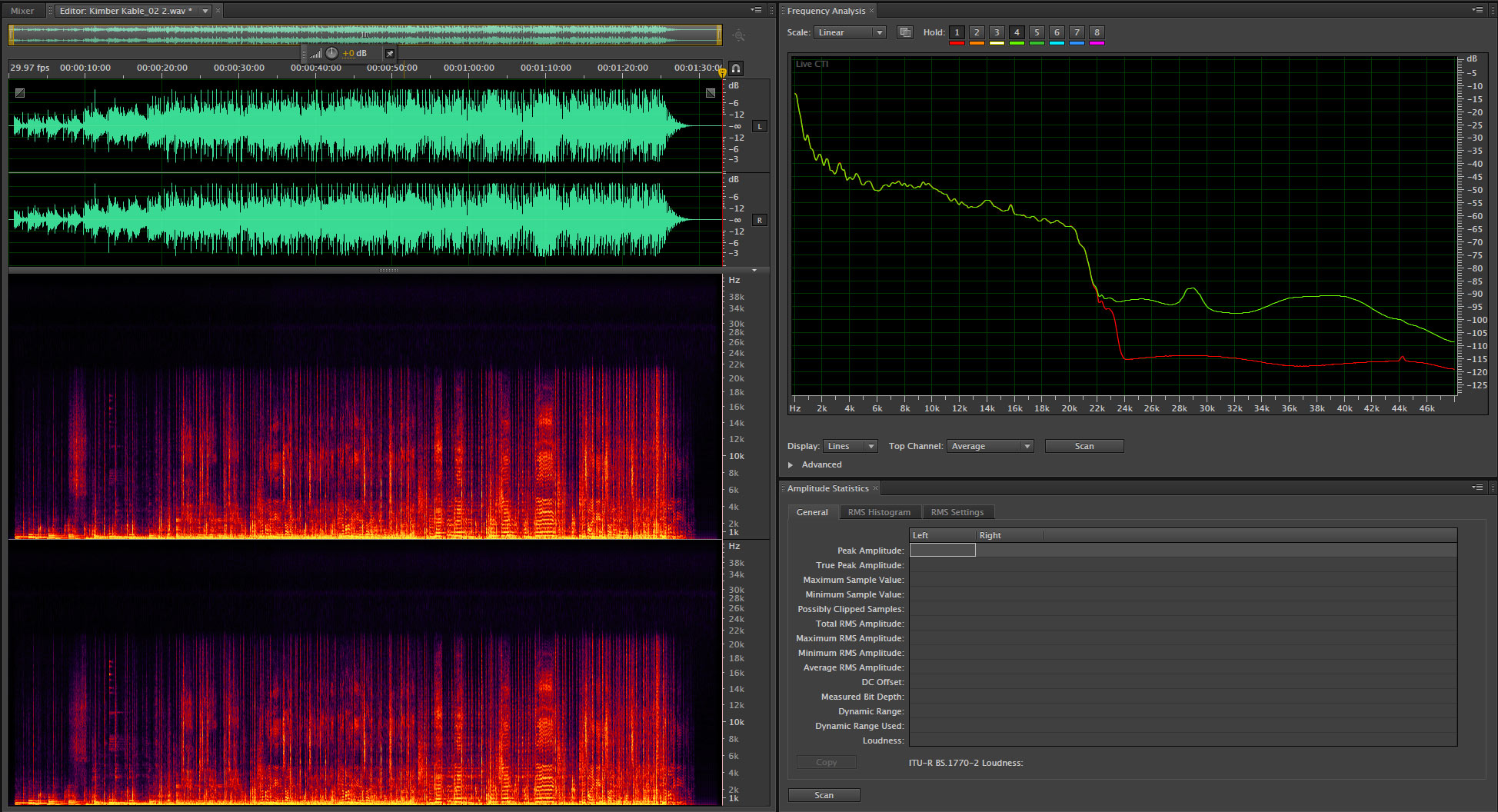Cable Curiosities
Talking about audio cables is sure fire way to start a comment war. Just this past week, I spent several hours with the top executive of a major audio company in the studio for a chat and some demonstrations. He’s headed a number of major audio enterprises including one of the premium cable companies. I’m not sure how we got on the topic of expensive power cords but we did. The discussion centered on the fact the designer of the company’s expensive cables was not an electrical engineer but had come up with a theory of why power needs solid metal conductors. He assured me that using one of the company’s expensive power cords to get from the wall to the component would enhance the low frequency fidelity of any component. I remained politely skeptical…as I have regarding most premium cables…but was intrigued.
So when an article came across my computer screen titled, “Managing Conductors” from the German publication Stereoplay that seems to have done extensive testing of a variety of interconnects, I was all in. You can read the pdf file yourself by clicking here. It’s an interesting article. There are discussions of resistance, capacitance and inductance (the R, C and L that describes the properties of cables) as they apply to electrical cables. And they include a fourth parameter called conductance (the letter G), “which is the reciprocal value of the insulation resistance separating the forward and return conductors electrically from each other”.
The article includes a comparison of about ten different RCA to RCA interconnects…with measurements and descriptions of the sound they produce. Starting with the “Standard red and white ‘in-the-box’ Cable”, the authors continue evaluating cables from familiar high-end cable companies including Mogami, Kimber, Audioquest, Cardas, Clearaudio, Silent Wire, and In Akustik. Prices range from less than one dollar to over $500 for a short 1-meter cable.
I found it fun that the article includes a couple of very quotable statements. Here are a couple of my favorites:
“Even if the audio cable manufacturers like to describe cable differences in orders of magnitude, they’re not as critical as speakers or even acoustic modifications of the listening room.” In other words, cables might result in very subtle differences in fidelity, but the changes are small, if present at all.”
“…even though there may be a direct relationship between the material cost of audio cables and their selling price, that does not necessarily mean that the more expensive cables provide higher fidelity.” It is possible that higher costing cables will change the fidelity of a reproduced selection of music, it is not assured. And it is also possible that more expensive cables will be sound worse.
You can read through the typical audiophile-friendly descriptions yourself. But there’s lots of “sounded decently balanced, however the midrange and presence region appeared milky, opaque and congested”, “It sounded impressive, precise, with sharp outlines and stable focus. Details were produced very clearly, without grit. Very spectacular, very informative – A real wow factor with quite vivid presence” and “a beautifully layered spatial impression, open and clear sound, particularly in the midrange”.
But the most fascinating thing about the tests was the ability of readers to download “Hi-Res” downloads of the source track as played from a Pro Tools rig using a Wandler AMI Musik DDH-1 DAC…and the curious results that I got when I did a spectrogram analysis of the various cables.
Take a look at the spectrograph of the selection as played using the standard Red/White cable and the Kimber Kable Timbre (at $440).
Figure 1 – The spectra comparing a “hi-res” track using a standard $1 cable vs. the $440 Kimber Kable Timbre. [Click to enlarge]
I was shocked to see that the Kimber cable has a spectrum with lots of added ultrasonics…frequencies that aren’t in the original signal. I checked all of the other cables and none of them strayed from the standard cable in the slightest. The frequencies plots were identical. I even reversed the polarity between a couple of them and the standard original…they zeroed each other out 100%. There was no measurable difference between the items I checked…yet the magazine reviewers found some to have better low end, less “congested sound”, etc.
The real question is what would cause the Kimber cable to produce levels of ultrasonic frequencies that are 20-30 dB higher than the actual signal? And would it make any difference in the fidelity? Unless something in the test files or procedures was amiss, I can’t figure it out. I guess I should ask my friend Ray Kimber.
I’ll close by pointing out the obvious fact that the “High-Res” selection…the one at 96 kHz/24-bits…is not actually a high-resolution file. The truth can be found by looking at the flat line on the left hand spectra…there are no frequencies above 22 kHz. In the right hand plot the rapid falloff at 22 kHz is also a guarantee that this is an upconverted CD track. No surprise, but why didn’t the magazine and reviewers point this out? Because they don’t know any better.



First DSD now cables. You may want to have someone start your car Mark! I am ……. unavailable!
Audio manufacturer Van Alstine has written extensively on subjective vs objective in audio, and cables. Hs writing on this topic is worth a read. Here is my non-EE interpretation (consult him for the better informed ‘skinny’:
Cables, being a passive item, cannot PRODUCE anything. However, they can REproduce high frequency oscillations produced by an ampifier (or preamp) that is sensitive to load characteristics. Basically, in this case anyway (as I understand it) ,the amp is oscillating and the cable is merely passing the oscillations through.
Frank Van Alstine is at most of the major audio shows,Mark; drop in and introduce yourself. He’s got a lot of insight into the particular topic.
Kimber Kable Timbres appear to be a newer version of Kimber interconnects that I had in my system some years back. They are basically a unshielded design as far as I can tell and the version I had gave me hum problems when used in different locations in my system. Could the ultrasonics you see be caused by some outside interference due to the unshielded design?
It certainly could.
I looked at these files a couple days ago. I did not get 100% nulling upon reversal. There was very, very little left. I aligned them to the nearest bit, but minor clock drift prevented total cancelling of the signals. Noticed the issue with Kimber. I also noticed if you looked at the FFT of the silence just before the music some cables showed 50 hz hum and others didn’t. The van den Hul showed by far the most hum probably because it has 5 ohms resistance.
Not that these differences were enough to explain the prose written about the sound differences. There simply is not enough difference in the files for that.
Thanks Dennis.
Ok Mark,
Here is a question which maybe you could answer.
I can change the sound of my high resolution stereo system by placing AAA magnets on the interconnects and/or speaker cables. No one has addressed how magnetic fields affect cables. Here is my take. (I secure AAA magnets with the + end toward the connection with electrical tape) .
Magnets clearly change the sound. They appear to decrease shrillness at the expense of dynamic range in a direct proportion. A few magnets make the musical presentation more listenable, but too many and the sound becomes diminished in both treble and dynamics. It is an odd phenomenon which is not currently described to my knowledge.
I thought you should know – I have no physics explanation.
Best,
Scott
Magnetism and electricity are very closely related. So it’s not big surprise that you can affect the sound of your system with magnets place in close proximity to your cables…and especially around low level signals (before the amplifiers). If the changes (which are always going to distort the accurate signal) are pleasant to you ears, then keep doing it. However, a great recording playing in a great system should eclipse the magnet modified rig.
I believe that the ultrasonic frequencies in the Kinder Kable are the result of external noise. From the next to last paragraph in the article, “Also worth noting is that the non-shielded Kimber and the Van den Hul with its relatively high shield resistance were somewhat sensitive to external noise sources such as fluorescent or energy saving lamps.” If you zoom into the fade out at the end of the file, it is especially easy to see the noise. Some of the other files show some noise, but not nearly as much as the Kinder Kable. For example, the Wireworld_Plat file shows occasional hum.
You’re right…it makes no sense to ignore proper shielding.
Kimber claims that their braided design alleviates the need for shielding. That was not my experience with them. I found my 1 meter sets of PBJ’s to be highly sensitive to hum pickup. Bought them after they received glowing reviews in all the major magazines in 1993. Another time I got burned by listening to the Golden Ear snake oil peddlers. 🙁
First of all Dr. “M” – thank you for removing a lot of the “haze” I’ve had about the whole deal of High Res downloads. Your frank and honest work will be saving me a ton of money! My main question about that subject is whether putting a 16 bit/44.1 CD into a “larger high-res envelope” causes an harm (other than to my wallet)?
As for “audiophile cables”, I’ve, for some time, have had a very nagging feeling about having to spend a high (if not VERY HIGH) percentage of a bought component’s price on a connecting cable(s) to make that component sound it’s best. Envisioning myself as a quality audio component maker, after spending years of research and development on my creation with the goal of bringing that product to market at the best quality and performance level (at ANY price point) – I would be totally embarrassed to find out from “others” that my component “absolutely” needed an expensive cable to perform to the capacity that I had in mind! As if NONE of my R&D when into making sure that any cable that the end-user would use would let all of that hard work go down the toilet! It seems, at the very least, I would “warn” the end-user to steer clear of these “inferior” cables to make sure my hard work would shine through…. I will be seeing you at T.H.E. Show this coming Friday (5/29) to shake your hand for letting me leave that event with a lot more $$$ than I would have. : )
Upconverting CDs to larger bit buckets doesn’t do any harm but doesn’t help things either. Even Neil and Ponomusic don’t do it. As for cables, think about the care that equipment makes take in their designs…internally they use good cables but not the major audiophile brands and they properly design the power supplies to avoid needing power conditioning and expensive power cords.
See you this weekend.
I think cables can “change” the sound but (in most cases I suspect) not necessarily because they’re revealing more information. As has been suggested above, some cables can alter the sound of a system because they are introducing unwanted noise, or, in the case of speaker cables, interfering with the output stage stability.
Hello Mark
Thank you for eliminating the mist over the cost of cable quality.
Very helpful info.
Cheers
Alphonso Soosay